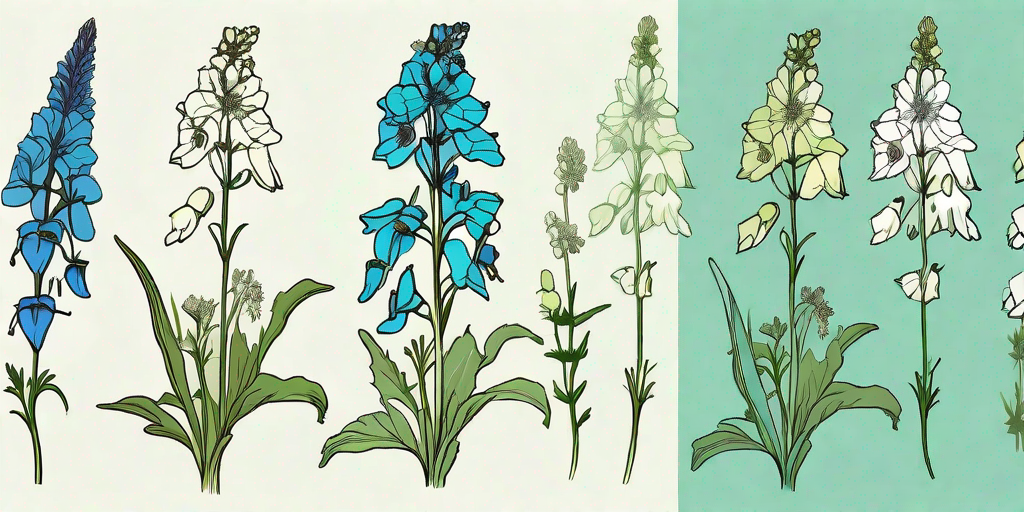
Delphiniums, with their vibrant hues and majestic height, are the showstoppers of any garden. These perennial beauties are known for their towering spires of blossoms that can reach up to six feet in height. But, growing delphiniums from seeds? Now, that's a challenge that can test even the greenest of thumbs. But fear not, dear reader, for we have the answers to turn your garden into a delphinium delight.
The Delphinium Basics
What are Delphiniums?
Delphiniums, also known as Larkspur, are a genus of about 300 species of perennial flowering plants in the family Ranunculaceae. They are native to the Northern Hemisphere and the high mountains of tropical Africa. The name "delphinium" comes from the Greek word "delphis," which means dolphin. This is due to the shape of the unopened flower, which resembles a dolphin's nose.
Delphiniums are popular in cottage-style gardens and cutting gardens. They are loved for their true blue blossoms, but they also come in shades of pink, white, and purple. The flowers bloom in late spring to early summer, and if you're lucky, they might give you a second show in late summer or early fall.
Are Delphiniums Difficult to Grow?
Well, let's just say that delphiniums are not for the faint-hearted. They require a bit of work and a lot of love. They are susceptible to a number of diseases and pests, and they need staking due to their height. But, the reward of seeing those towering spires of blossoms is worth every bit of effort.
One of the biggest challenges of growing delphiniums is getting them to grow from seeds. But, with the right knowledge and a bit of patience, you can successfully grow these beauties from tiny seeds.
How to Grow Delphiniums from Seeds
Step 1: Choosing Your Seeds
When it comes to choosing delphinium seeds, you have a plethora of options. There are single-flowered and double-flowered varieties, and they come in a range of colors. Choose a variety that suits your garden's conditions and your personal preferences.
It's important to buy your seeds from a reputable source to ensure they are healthy and viable. Look for seeds that are dark and plump. Avoid seeds that are light in color or shriveled, as they may not germinate.
Step 2: Starting Your Seeds
Delphinium seeds can be started indoors in late winter or early spring. Fill a seed tray with a good quality seed compost and sow your seeds on the surface. Cover the seeds lightly with compost or vermiculite, as they need light to germinate.
Keep the seed tray in a warm place, ideally at a temperature of 15-20°C. The seeds should germinate in 14-21 days. Once the seedlings are large enough to handle, transplant them into individual pots.
Step 3: Planting Out
Delphiniums can be planted out in late spring or early summer, once the risk of frost has passed. Choose a sunny spot with well-drained soil. Delphiniums prefer slightly alkaline soil, so you may need to add lime to your soil if it is acidic.
Plant the delphiniums at the same depth they were growing in their pots. Space the plants about 2 feet apart to allow for good air circulation. Water the plants well after planting.
Caring for Your Delphiniums
Watering and Feeding
Delphiniums need regular watering, especially during dry spells. However, avoid overwatering as this can lead to root rot. A layer of mulch around the plants can help retain moisture in the soil.
Feed your delphiniums with a balanced fertilizer in early spring and again in midsummer. This will promote strong growth and abundant flowering.
Staking
Due to their height, delphiniums need staking to prevent them from toppling over. Use garden canes or stakes and tie the plants loosely to the stakes as they grow.
It's best to stake your delphiniums early in the season, before they get too tall. This way, the stakes will be hidden by the foliage as the plants grow.
Common Problems and Solutions
Slugs and Snails
Slugs and snails love delphiniums, and they can cause significant damage to the plants. To deter these pests, you can use organic slug pellets or create a barrier around your plants with crushed eggshells or copper tape.
Powdery Mildew
Powdery mildew is a common problem for delphiniums. This fungal disease causes a white powdery coating on the leaves. To prevent powdery mildew, ensure good air circulation around your plants and avoid overhead watering. If your plants are affected, treat them with a fungicide.
Frequently Asked Questions
- Can I grow delphiniums in pots?
Yes, delphiniums can be grown in pots. However, due to their height, they are best suited to large, deep pots. Make sure the pot has good drainage to prevent waterlogging.
- Do delphiniums come back every year?
Yes, delphiniums are perennials, which means they come back every year. However, they may not survive harsh winters, so it's a good idea to mulch around the plants in the fall to provide some protection.
- Can I grow delphiniums from cuttings?
Yes, delphiniums can be propagated from cuttings. However, this method is more difficult than growing from seeds, and it requires a bit of skill and patience.
In conclusion, growing delphiniums from seeds can be a bit of a challenge, but it's a rewarding experience. With the right care and attention, you can enjoy the spectacular display of these towering beauties in your garden. So, why not give it a try? After all, every garden needs a bit of drama, and delphiniums are the perfect stars for the show.















